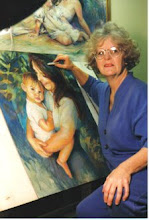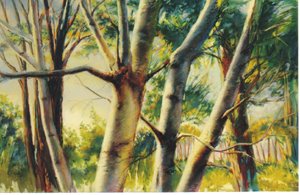How do you get in the zone as an artist?
Go on an adventure.
You want to create a work of art. Start by asking yourself:
What is my mission?
What is my goal?
Then it's time to search. Find a subject - landscape - still life - etc. Plan plan plan - search and research.
Every work of art is comprised of endless choices.
When you get a good idea, you want to give yourself as many options as you can imagine.
Consider these variables:
Chosen type of media - size of surface you
work on - horizontal or vertical orientation - changing the light source
- seasons and time of day.
Get to understand your materials. Search. Question
your idea - maybe a better idea is hidden in the research.
Everyone reads from left to right - try reading from right to left or upside-down. Every choice opens you up to new ideas - ways of doing things -
awareness of higher planes of mental connections. When you start
painting you are ready to work with your muse - your higher self. The
power in you that whispers in your ear or flashes an idea into your mind
just when you need it.
Then it's time to create. Start with
a simple drawing. Spend time studying your subject.
What inspired you
to choose this subject? What is your center of interest? Motivation?
You are free to make choices and free to change your mind.
You are free to make choices and free to change your mind.
Thumbnail
sketches help build your connection with your subject and strengthen
your choices of composition. They take approximately 1 minute. Shape - values - change. Keep it simple.
I
chose a lighthouse. Why? For many years when we traveled around Lake
Michigan our favorite stops were the lighthouses. I loved the
water, beaches, sand, and trees. I loved the morning, evening, rain, and wind.
I could have walked forever. I have a great many memories.
I
began with a light pencil sketch, then I did several thumbnail sketches
for composition. It should have been a simple choice - the sketch I
chose started out
to be a good composition but after I laid it in, it became clear there
was no drama. When I get this far, the piece should be heading toward
great. If not, then I know I need further study into what
inspired me to do the piece of art. I need to know what is missing.
When I study it, I should feel it is the greatest
artwork I have ever done, not that it needs something.
I
have other artwork that has priority so this one will go on the shelf where I
can study it while I work on other pieces. When I get back to this piece I will be ready for the next step in my process. When I finish it I will frame it and send it to a gallery. If I don't finish it... ?







